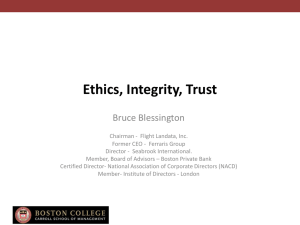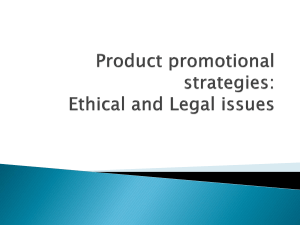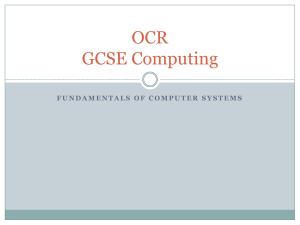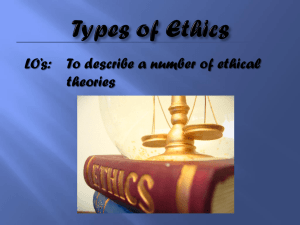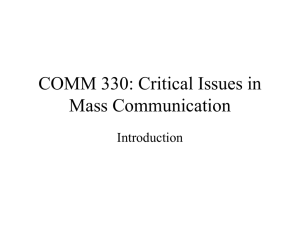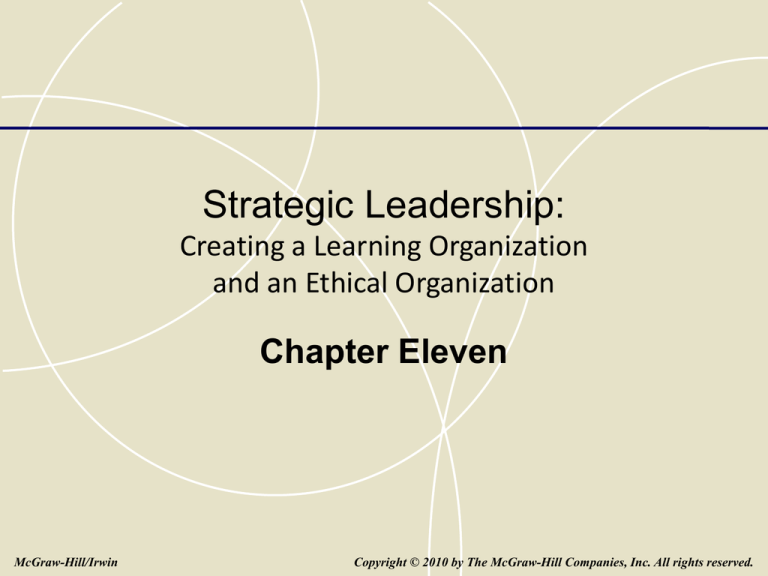
Strategic Leadership:
Creating a Learning Organization
and an Ethical Organization
Chapter Eleven
McGraw-Hill/Irwin
Copyright © 2010 by The McGraw-Hill Companies, Inc. All rights reserved.
Three Interdependent Activities
of Leadership
11-2
Setting a Direction
• Scan environment to develop
Knowledge of all stakeholders
Knowledge of salient environmental trends
and events
• Integrate that knowledge into a vision of
what the organization could become
11-3
Designing the Organization
• Designing the organization
A strategic leadership activity of building
structures, teams, systems, and
organizational processes that facilitate the
implementation of the leader’s vision and
strategies.
11-4
Designing the Organization
• Difficulties in implementing the leaders’
vision and strategies
Lack of understanding of responsibility and
accountability among managers
Reward systems that do not motivate individuals and
groups toward desired organizational goals
Inadequate or inappropriate budgeting and control
systems
Insufficient mechanisms to coordinate and integrate
activities across the organization
11-5
Nurturing an Excellent and
Ethical Culture
• Excellent and ethical organizational
culture
an organizational culture focused on core
competencies and high ethical standards
11-6
Overcoming Barriers to Change
• Reasons why organizations are prone to
inertia and slow to change
Vested interests in the status quo
Systemic barriers
Behavioral barriers
Political barriers
Personal time constraints
11-7
The Effective Use of Power
• Power
a leader’s ability to
get things done in a
way he or she wants
them to be done.
• Organizational
bases of power
A formal management
position that is the
basis of a leader’s
power.
11-8
Inspiring and Motivating People with a
Mission or Purpose
• A Learning environment involves:
Organization-wide commitment to change
An action orientation
Applicable tools and methods
Guiding philosophy
Inspired and motivated people with a
purpose
11-9
QUESTION
The "top down" perspective of
empowerment
A. Encourages intelligent risk-taking
B. Trusts people to perform
C. Encourages cooperative behavior
D. Delegates responsibility
11-10
Empowering Employees
at All Levels
Top-down perspective
• Start at the top.
• Clarify the organization’s mission, vision, and
values.
• Clearly specify the tasks, roles, and rewards for
employees.
• Delegate responsibility.
• Hold people accountable for results.
11-11
Empowering Employees
at All Levels
Bottom-up View
• Start at the bottom by understanding needs of
employees
• Teach employees skills of self-management
• Build teams to encourage cooperative behavior
• Encourage intelligent risk taking
• Trust people to perform
11-12
Challenging the Status Quo and
Enabling Creativity
• Create a sense of urgency
• Establish a “culture of dissent”
• Foster a culture that encourages risk
taking
• Cultivate culture of experimentation and
curiosity
11-13
Best Practices: Learning from Failures
11-14
Creating An Ethical Organization
• Ethical orientation
the practices that firms use to promote an
ethical business culture,
Includes ethical role models, corporate
credos and codes of conduct, ethically-based
reward and evaluation systems, and
consistently enforced ethical policies and
procedures.
11-15
Creating An Ethical Organization
• Ethical values
Shape the search for opportunities
Shape the design organizational systems
Shape the decision-making process used by
individuals and groups
Provide a common frame of reference that
serves as a unifying force
11-16
Integrity-Based versus ComplianceBased Approaches
• Compliance-based ethics programs
programs for building ethical organizations
that have the goal of preventing, detecting,
and punishing legal violations.
11-17
Integrity-Based versus ComplianceBased Approaches
• Integrity-based ethics programs
programs for building ethical organizations
that combine a concern for law with an
emphasis on managerial responsibility for
ethical behavior,
11-18
Integrity-based Ethics Programs
Integrity-based Ethics Programs include:
1. enabling ethical conduct;
2. examining the organization’s and
members’ core guiding values, thoughts,
and actions; and
3. defining the responsibilities and
aspirations that constitute an
organization’s ethical compass.
11-19
Key Elements of Highly
Ethical Organizations
•
•
•
•
Role models
Corporate credos and codes of conduct
Reward and evaluation systems
Policies and procedures
11-20


